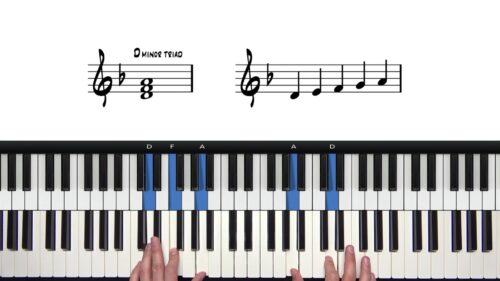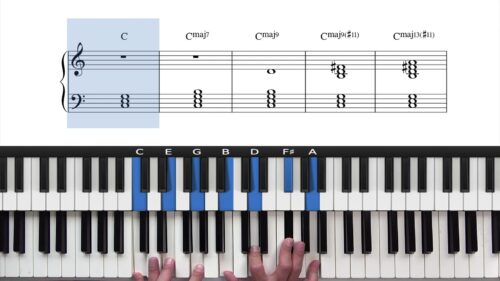Triad Based Improv Drills
In this blues improvisation lesson we cover a series of drills and exercises to help you develop improvised melodic ideas using triads.
It’s crucial to understand that while our ideas are based on triad shapes, we’re not confined to these notes exclusively. This approach allows for the inclusion of chromatic notes to create more interesting triad-based melodic lines.
Chord Tones & Target Tones
We begin with the F7 chord, examining the notes of the triad (F, A, and C) and exploring the chromatic possibilities within. We start with simple one-bar phrases and practice the same idea over all three chords in the basic 12-bar blues progression in F.
For example, targeting the 3rd of the F7 chord, moving up to the 5th, and then chromatically descending to the 9th, always while visualising the triad shape and considering the chromatic pathways that exist within.
Enclosures & Approach Patterns
An important aspect of this lesson is the introduction of enclosures, a technique where dissonant notes are used to enhance the resolution to a more stable tone or resting place. This concept is applied to all 3 chords of the 12-bar blues form, emphasizing the importance of maintaining a solid groove in the left hand, even when incorporating more complex right-hand techniques.
Lesson Downloads
-
Triad Improvisation Drills File Type: pdf
Practice Tips
-
The triad lines are meant to sound like an exercises at this stage. The goal is to build strong foundations in triad-based melodies before introducing the 6th and 7th in the next lesson.
-
Begin by familiarizing yourself with the basic triad shapes for each chord in the 12-bar blues progression in F. Play these triads in different positions and registers on the piano.
-
Experiment with adding chromatic notes within these triad shapes to understand how they can enhance your melodic lines.
-
Start with one-bar phrases for each chord. Focus on targeting specific notes like the third, fifth, and ninth of the chord.
-
Practice pulling and pushing the timing of your phrases. Experiment with holding certain notes longer and playing others quicker to create different rhythmic feels.
-
Integrate the triad ideas with the space fillers we covered in the previous modules learned. We explore this further in the next lessons of this module.








How do you count theses riffs?
Hi Rick 👋
When I’m playing the slow blues style I am always feeling/counting a 12/8 pulse.
1-2-3-1-2-3-1-2-3-1-2-3
or
1-&-a-2-&-a-3-&-a-4-&-a-
I have attached a graphic below showing how this subdivision is applied to the phrase.
The tricky part is ‘the turn’ and how this fits into the counting.
You can try removing the turn (which happens on the ‘2’ of the 2nd and 4th group of triplets)
ie: 1-2-3-1-2-3-1-2-3-1-2-3
and that makes it much easier to count.
By playing through the form many times whilst counting/verbalising the 12/8 pulse, this underlying pulse will become engrained within you.
This helped me to become more flexible with my timing and allows me to ‘pull and push’ on the exact note durations of my melodies whilst staying locked into the underlying groove.
On a related note, I’m almost finished recording the new “Slow Blues Substitutions & Improv” course which uses the key of C.
I’ve found that by introducing chord substitutions into the blues, it creates a lot more melodic possibilities which has really ‘opened doors’ for me in terms of creating more interesting and varied improvisation in this style.
Keep an eye in the forum for updates as the new lessons will be ready in the next couple of weeks.
Talk soon,
Hayden